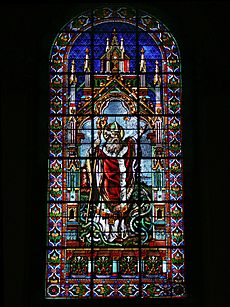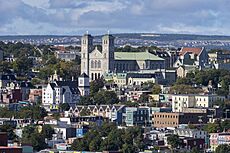Basilica of St. John the Baptist facts for kids
Quick facts for kids Basilica-Cathedral of St. John the Baptist |
|
|---|---|
 |
|
| Religion | |
| Affiliation | Roman Catholic |
| District | Archdiocese of St. John's |
| Ecclesiastical or organizational status | Minor basilica Metropolitan cathedral |
| Leadership | Archbishop Peter Hundt |
| Location | |
| Location | 200 Military Road St. John's, Newfoundland and Labrador A1C 5M3 |
| Architecture | |
| Architect(s) | John Philpot Jones |
| Architectural type | Latin Cross, basilica |
| Architectural style | Lombard Romanesque |
| Completed | 1855 |
| Specifications | |
| Direction of façade | East |
| Capacity | 2,500 seated |
| Length | 85 metres (279 ft) |
| Width | 65 metres (213 ft) |
| Width (nave) | 16 metres (52 ft) |
| Height (max) | 48 metres (157 ft) |
| Materials | Irish granite & limestone Newfoundland sandstone Italian marble Egyptian travertine |
| Official name: Basilica of St. John the Baptist National Historic Site of Canada | |
| Designated: | 1983 |
The Basilica-Cathedral of St. John the Baptist is a very important Roman Catholic church in St. John's, Newfoundland and Labrador. It is the main church for the Roman Catholic Archdiocese of St. John's, Newfoundland. This beautiful building is a symbol of the Catholic faith in Newfoundland. It is located in the St. John's Ecclesiastical District, which is a special historic area in Canada.
Building the Basilica-Cathedral was the biggest construction project in Newfoundland at the time. Work started in May 1839 and finished in September 1855. When it was completed, it was the largest church in North America. Today, it is still the second largest church in Canada, after Saint Joseph's Oratory in Montreal. It is also the biggest cathedral church in Canada. The Basilica-Cathedral was one of the few buildings in St. John's that survived the Great Fire of 1892. In 1955, Pope Pius XII gave the cathedral the special title of a minor Basilica.
In recent years, there were discussions about the future of the Basilica. However, a special foundation stepped in to buy it and make sure it stays open as a Catholic church for the city.
Contents
History of the Basilica

The Basilica-Cathedral was built between 1839 and 1855. It stands on the highest hill overlooking the city of St. John's, Newfoundland and Labrador. The church is not built facing east or the harbour entrance. Instead, it faces the rising sun on the shortest day of the year (Winter Solstice). It also faces the setting sun on the longest day of the year (Summer Solstice). This is similar to how some old European cathedrals were built.
The Basilica-Cathedral of St. John the Baptist is shaped like a Latin cross. It is built in the Lombard Romanesque style, which is a type of Roman architecture. Bishop Michael Anthony Fleming planned the church. He worked with architects like Ole Joergen Schmidt and John Philpot Jones. The construction was overseen by Michael McGrath and later by James Purcell.
Bishop Michael Anthony Fleming and his successor, Bishop John Thomas Mullock, watched over the building process. What makes this church special is that it used materials from far away. It has limestone and granite from Ireland. It also used 400,000 bricks from Hamburg, Germany. Local stone from St. John's and Kelly's Island in Conception Bay was also used. This mix of materials gives the cathedral its unique grey color.
The St. John's Basilica-Cathedral was built during a time when many churches were being constructed. This was happening in Ireland and Newfoundland. For its time, it was the largest Irish cathedral outside of Ireland.
In 1955, during its 100th anniversary, Pope Pius XII gave the cathedral the title of a minor Basilica. In 1983, the Basilica became a National Historic Site of Canada. This was to recognize its special architecture. It was one of the first buildings in North America built in the Romanesque revival style. It is also important as the spiritual home for Roman Catholics in Newfoundland. The building is also a Registered Heritage Structure.
Architecture and Design
The Basilica-Cathedral is built in the Lombard Romanesque style. This style uses features often seen in churches in northern Italy. The building uses grey limestone and white granite from Ireland. It also has grey sandstone from St. John's and Kelly's Island in Newfoundland.
The outside of the church is about 85 meters (260 feet) long and 67 meters (220 feet) wide. Its two towers rise about 46 meters (150 feet) from the street. The Basilica can hold about 2,500 people. When it was finished in 1855, it was the largest church building in North America.
The East Tower has one large bell. It is called the St. John Bell and weighs two tons. Bishop Mullock bought this bell in 1850. It was the largest bell ever made in Ireland at that time. The West Tower has eight bells. The three biggest bells were made in 1854 and 1857. The five smaller bells were made in 1906.
The Basilica-Cathedral has 28 stained glass windows in its upper walls. These windows were made in England and France. They were given as gifts by different groups and people. They were put in place between 1859 and 1905. There are also 35 stained glass windows in another part of the church. These were made in 1954-1955. They are the largest collection of Irish Arts and Crafts style stained glass windows in one building in the western world.
Inside the Basilica
The Altar of Sacrifice is at the front of the church. It holds a very important statue called The Dead Christ. This statue was carved from Carrara marble by the famous Irish sculptor John Hogan in 1854. Bishop Fleming wanted this statue for the Cathedral. Bishop Mullock, his successor, brought the statue to St. John's in 1855. This statue is considered Hogan's greatest work. It is the only one of its kind by Hogan located outside of Ireland.
The Sacred Heart Altar and the Altar of the Immaculate Conception are also inside. They are made from the same Egyptian travertine stone that was used to decorate a famous church in Rome. A small amount of this stone was given to Bishop Mullock by the Pope. He brought it to St. John's in 1856 to finish the church's interior.
In 1955, a large pipe organ was installed in the church. It was made by a company in Quebec. This organ has 66 stops and 4,050 pipes. It is the largest musical instrument in Newfoundland. It is also one of the largest pipe organs east of Montreal.
Basilica Museum
The Basilica Museum is open during certain times of the year. It is located in the Episcopal Library, which is next to the Archbishop's Palace. The museum shows religious art and old items from the Basilica. It also has pictures of past bishops and archbishops. You can also see furniture and decorations from different time periods in the Palace. Both the Episcopal Library and the Archbishop's Palace are also National Historic Sites of Canada.
Burials
- Some important church leaders are buried in the crypt under the High Altar:
- Edward Patrick Roche (Archbishop of St. John's)
- Thomas Scallan (Bishop of St. John's)
- John T. Mullock (Bishop of St. John's)
- Thomas Joseph Power (Bishop of St. John's)
- Michael Anthony Fleming (Bishop of St. John's)
See also
 In Spanish: Catedral basílica de San Juan Bautista (San Juan de Terranova) para niños
In Spanish: Catedral basílica de San Juan Bautista (San Juan de Terranova) para niños
- Architecture of St. John's
- Roman Catholic Archdiocese of St. John's, Newfoundland





